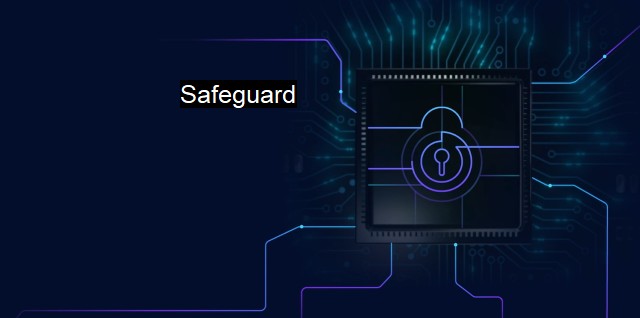What is Safeguard?
The Importance of Safeguards in Cyber Security: Everything You Need to Know About Protecting Yourself from Online Threats
Safeguard is an umbrella term involving various techniques, measures, and technologies designed to protect computer systems, networks, applications, programs, and data. These safeguards strictly imply the adherence to defined procedures that limit the access and potential harm caused by unauthorized users and protect systems from adverse scenarios such as security breaches, data theft, blackmail schemes, and other cyber threats.One of the core elements of safeguarding in cybersecurity and antivirus is Identifying and Countering Vulnerabilities. Technological vulnerabilities can act as entry points for cybercriminals to gain unauthorized access or to launch a cyber-attack. These vulnerabilities can exist in software, hardware, network connections, or user practices. Security professionals conduct regular system health checks, vulnerability assessments, and penetration testing to spot these vulnerabilities.
Another important aspect is safeguarding through Antivirus Applications. these are software programs designed to identify, block, and remove viruses and malware. Antivirus software essentially acts as the first line of defense against threats. It routinely scans files and systems for any malicious and suspicious activities, while its databases are regularly updated with new definitions to tackle zero-day threats.
Implementing Firewall Protection is another significant safeguard measure. Acting as a security gatekeeper between an internal network and the outside world i.e, the internet, firewalls monitor and controls incoming and outgoing network traffic based on predetermined security rules. They prevent unauthorized access while permitting outward communication, thereby adding an extra layer of security.
In terms of safeguarding methodologies, Encrypting Sensitive Data is taken into serious consideration. By converting readable data into coded form, it ensures that even if hackers manage to infiltrate a network and gain access to confidential data, it remains useless and unreadable to them without a unique decryption key.
Next is User Education. As humans, we are often the weakest links in cybersecurity. Hence, implementing technical safeguards is not enough. Guiding individuals to be aware of phishing attacks, use strong passwords, double-checking email attachments, and educating them about safe browsing practices and policy adherence forms an integral part of considering safeguard factors.
The factor of Regular and Backup Recovery Plans is also intrinsically associated with safeguarding in cybersecurity. Regular backing up of data, either in standalone hardware or cloud-based storage, prevents data loss during cyberattacks and minimizes the recovery time period.
Lastly, Regular Updates and Patches cannot be ignored. Technology evolves at an exhilarating pace. As a result, cybercriminals are also quick to develop new means to infiltrate systems and networks. Regular software, firmware, and security patches release serve as ways to correct faults, improve system functionalities and provide added security features to enhance the safeguarding process. This ensures that the system stays ahead of the curve to discourage any possible threats effectively.
Cybersecurity and antivirus safeguard measures are vast and evolving. With the rise of cyber threats, businesses, infrastructures, and even individuals have started to recognize the importance of these safeguards. Early adoption of these measures not only maintains business continuity and public confidence but can also save gallons of time and money that might otherwise be lost in recovering from a cyber attack. As a part of a larger cyber hygiene routine, a combination of these measures provides comprehensive protection and security.

Safeguard FAQs
What is Safeguard in cybersecurity?
Safeguard in cybersecurity refers to the set of measures taken to protect computer systems, networks, and data from unauthorized access, theft, or damage. It includes a range of security solutions such as firewalls, antivirus software, encryption, and intrusion detection systems.How does antivirus safeguard a computer system?
Antivirus software is designed to detect and remove malware, such as viruses, spyware, and ransomware, from a computer system. It works by scanning files and programs for malicious code and quarantining or deleting any threats that are detected. Antivirus software also includes real-time protection to prevent malware from infecting a system in the first place.What are the benefits of using Safeguard in cybersecurity?
The benefits of using Safeguard in cybersecurity include protecting sensitive data from theft or compromise, preventing unauthorized access to computer systems and networks, and ensuring business continuity by reducing the risk of system downtime due to cyberattacks. Safeguard measures also help organizations comply with industry and government regulations related to data privacy and security.How can I implement Safeguard measures in my organization?
To implement Safeguard measures in your organization, you should conduct a risk assessment to identify potential security threats and vulnerabilities. Based on the assessment, you can then implement appropriate security solutions such as firewalls, antivirus software, and intrusion detection systems. It's also important to establish security policies and protocols, train employees on cybersecurity best practices, and regularly monitor and update your security measures to stay ahead of evolving threats.| | A | | | B | | | C | | | D | | | E | | | F | | | G | | | H | | | I | | | J | | | K | | | L | | | M | |
| | N | | | O | | | P | | | Q | | | R | | | S | | | T | | | U | | | V | | | W | | | X | | | Y | | | Z | |
| | 1 | | | 2 | | | 3 | | | 4 | | | 7 | | | 8 | | |||||||